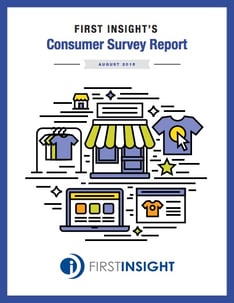New survey reveals preferences of today’s modern consumer: in-store technology, marketing, pricing and social media
 |
| Download Full Report |
PITTSBURGH, PA, August 12, 2015 – Retailers are making big bets on in-store technology and marketing, but they shouldn’t rely on a one-size-fits-all approach. A consumer survey from First Insight, the leading provider of solutions that empower brands to incorporate the voice of the consumer into the design and merchandising of new products, sheds new light on the modern consumer's mindset and retail experiences today.
Technology Takeover: What’s In-store for Consumers
Retailers have a ripe opportunity to use technology to better understand consumers in a more meaningful way, from tools such as First Insight’s InsightSuite, which helps retailers understand pricing preferences, inventory and marketing best practices, to beacon technologies that help retailers communicate promotions.
For in-store technologies, retailers will walk a fine line between losing and winning customers with the introduction of new capabilities. Despite the hype over facial recognition technology, retailers will fight an uphill battle with consumers, with more than 75 percent of respondents revealing they would not shop at a store that used facial recognition technology for marketing purposes. However, discounts might be the key to turning consumer perception around, as the number dropped to 55 percent of respondents when they knew there would be a benefit associated with it.
Beacons are by far the most talked about in-store technology, but consumer awareness of the technology and its benefits are very low, with 70 percent of respondents not knowing the definition of an in-store beacon. But don’t count out “old” tech just yet. Respondents identified price barcode scanners as the most helpful in-store technology, symbolizing the importance of price to consumers.
The Golden Rule for Retailers: Price Comes First, Social Media Last
The biggest shopping days of the year all revolve around one thing: deals. From Black Friday to Cyber Monday, consumers gravitate toward the best price for the highest quality products, indicating the need for well-designed products at a fair price point. For millennials, price is especially key as more than 40 percent of this group considered it the most important factor when purchasing an apparel item.
Despite the rise of using social media in the workplace and at home, consumers haven’t taken it in-store. More than 60 percent of respondents never interact with a retailer’s social media platforms while shopping in-store, presenting an opportunity for retailers to refine their marketing strategies.
Modern Marketing: Say Goodbye to Celebs and Print
The days of “Like Mike” are gone and consumers are setting their own style. More than 90 percent of respondents indicated they aren’t more likely to buy an apparel item if an athlete or celebrity endorses it. That means big potential savings for retailers as marketers are planning to spend $600 billion worldwide this year, part of which goes toward hiring celebrities and sports stars for product endorsements.
Consumers continue to be more inspired by top Instagram stars and less impressed by models in fashion magazines, and millennials are at the forefront. Only 5 percent of millennials identified fashion magazines as the way they keep up with fashion trends. However, there’s still some hope for print if you’re looking to reach those that are over age 50, as 40 percent of those respondents identified it as the key means in which they discover promotional materials.
Even though many millennials today are glued to their smartphones, 98 percent of millennials don’t want to be texted by retailers about promotions. Respondents between the ages of 18 and 50 identified that they prefer receiving promotions via email.
“This survey revealed the importance to retailers in understanding their target consumer, from their preferences regarding in-store technologies to the small but important details such as whether it’s better to reach them by text or email,” said Jim Shea, Chief Marketing Officer of First Insight. “Consumers today expect the shopping experience to be personalized and want retailers to evolve along with their preferences.”
The report with more detailed statistics and conclusions from the survey can be found here.
Methodology
First Insight’s consumer retail survey polled 1,085 consumers across America regarding their thoughts about retail technologies, shopping experiences and how they are impacted by retailer marketing and advertising efforts. The survey was conducted online between June 12 and June 16, 2015. The margin of error is +/- 2.89 percent.
About First Insight, Inc.
First Insight is the world’s leading provider of solutions that empower brands to incorporate the voice of the consumer into the design and merchandising of new products. Through the use of online consumer engagement, the First Insight solution gathers real-time consumer data and applies predictive analytic models to create actionable insights, which drive measurable value. Retailers, manufacturers and brands use the First Insight solution to design, select, price and market the most profitable new products for improved sales, margins and inventory turnover. Customers include some of world’s leading vertically integrated brands, sporting goods companies, department stores, mass merchant retailers and wholesalers. For further information, please visit www.firstinsight.com.
Media Contact:
Gina Giachetti
Highwire PR
(415) 963-4174 ext. 17
gina@highwirepr.com
Company Contact:
Jim Shea
Chief Marketing Officer
First Insight, Inc.
(724) 759-7141
jim.shea@firstinsight.com













